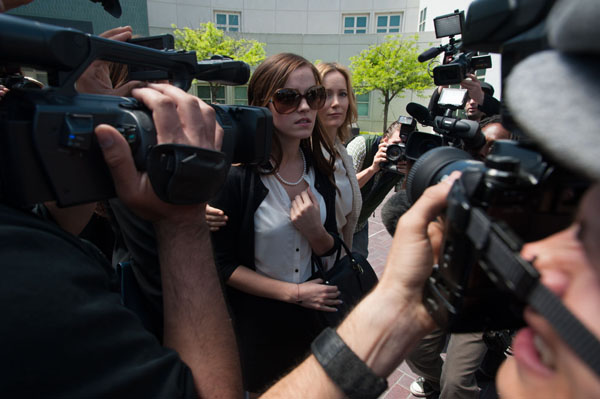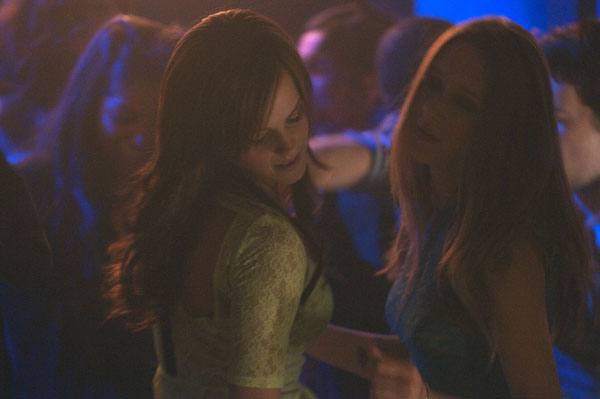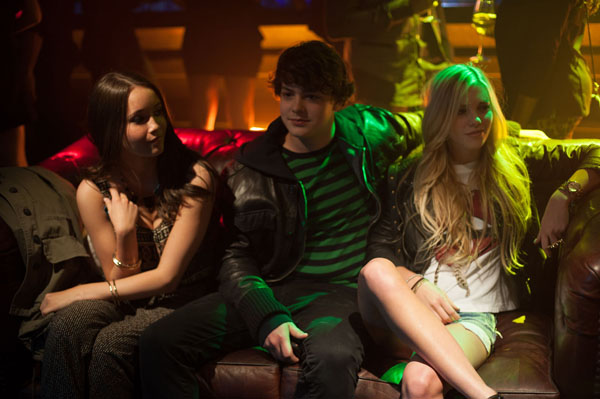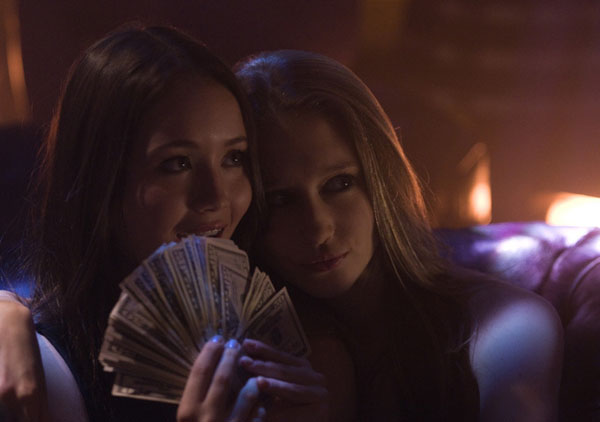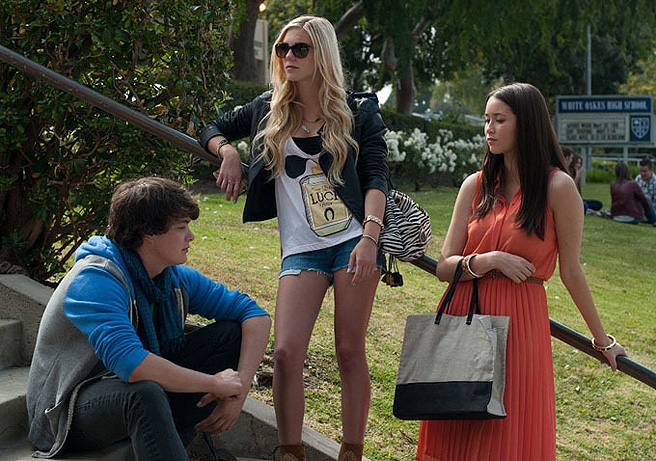“Sofia Coppola delivers a wily critique of celebrity culture in The Bling Ring [site] as she dresses up the true story of Los Angeles teenagers robbing their Hollywood idols’ homes,” begins Kaleem Aftab in the Independent. “Coppola is a specialist in demystifying the lives of the rich and famous. In Lost in Translation her cynicism was aimed at a movie star transformed by his fame. Her flamboyant Marie Antoinette recast the French monarch as the frustrated Princess Diana of her time. She won a Golden Lion when she set her movie Somewhere inside Hollywood hangout Chateau Marmont in which the life of her actor protagonist is shown as tediously lethargic. In The Bling Ring, the teenage suspects, the self-obsessed parents and the celebrities, who have more possessions than a department store, are given a bashing with a designer handbag.”
David Jenkins at Little White Lies: “Based on Nancy Jo Sayles’ juicy Vanity Fair longread entitled ‘The Suspects Wore Louboutins,’ The Bling Ring is a scintillating and snappy true crime saga that descends partly from the tradition of Truman Capote’s In Cold Blood, and partly from Kenneth Anger’s tittle-tattle scandal compendium, Hollywood Babylon. Mix in the usual dash of Fellini, some Sex and the City, and even a bit of Spring Breakers, and you’re almost there. The film it’s most similar to is Gus Van Sant’s Paranoid Park, particularly in its shrewd, glassy-eyed view of modern teen disillusionment.”
Film Comment seems to have taken down Kent Jones‘s early review, but when it was up, we noted that he wrote: “Unlike Spring Breakers, with which the film will inevitably be compared (alongside Schrader’s The Canyons), The Bling Ring goes about its business quietly but with a tremendous purity of focus. The film casts such a lovely spell that its full force may hit only after the lights come up.” He also suggests that one might call Coppola “a neorealist of hyper-materialist life.”
“They target the homes of, among others, Paris Hilton, Lindsay Lohan, Audrina Patridge, Megan Fox, and Rachel Bilson,” writes Graham Fuller for Vanity Fair. “They thrill at their proximity to the celebs (yet bizarrely discard a love letter found chez Orlando Bloom). Their haul in designer loot is enough to make law-abiding fashionistas in the audience salivate…. Coppola’s film is both an incisive critique of Hollywood materialism and a cautionary fable about teen amorality and Facebook-era narcissism.”
Stephen Galloway profiles Coppola for the Hollywood Reporter: “At first, she optioned the underlying material for her family’s company, American Zoetrope, without planning to direct. But the more she learned about the case—helped by transcripts of interviews with the teenagers and police records Sales sent her—the more intrigued she became…. ‘[T]hese kids are obsessed with the idea that anybody can be famous and everybody should be.’ … Meanwhile, she reached out to the teenagers involved in the crimes. ‘I spoke to [Alexis Neiers and Nick Prugo] and the detective, Brett Goodkin,’ she recalls. ‘Alexis still claims to be innocent and that she wasn’t involved in anything. She just stuck with her story.'”
Indeed, as Ben Child notes in the Guardian, Neers has been tweeting her disapproval of the movie: “It’s trashy and inaccurate… The truth will come out soon enough and I have no intention of seeing this film.”
Also in the Guardian, Ryan Gilbey profiles Watson: “We no longer look at Jodie Foster or Drew Barrymore through their childhood performances and Watson is doing her damnedest to ensure that the slate is wiped clean for her, too.”
Sales has expanded her Vanity Fair article and the book’ll be out next week. And basically, VF‘s Alyssa Bereznak asks her why.
Updates: “Some would argue,” notes In Contention‘s Guy Lodge, “that this is well-worn territory for Coppola, an unapologetically silver-spoon-fed filmmaker who has charted the ennui and corruption of celebrity culture in every film she’s made since her 1999 debut The Virgin Suicides—which at least bookends The Bling Ring as a study in warped adolescent self-actualization. But to lazily rehash already skimpy jabs at Coppola for her privileged tunnel vision would be to miss her new film’s significant shift in perspective. After three films about those firmly ensconced in the ivory tower – the Chateau Marmont in one incarnation, the Palace of Versailles in another—Coppola is, for the first time, on the outside looking in…. What’s gratifyingly fresh about the film is Coppola’s refusal to sentimentalize the kids’ crimes as a form of starry-eyed celebrity desire.”
“When future generations want to understand how we lived at the dawn of the plugged-in, privacy-free, Paris Hilton-ized 21st century, there will likely be few films more instructive than The Bling Ring,” suggests Variety‘s Scott Foundas, who calls the film a “spiritual sequel of sorts to The Social Network…. In Coppola’s telling, Neiers becomes Nicki (Emma Watson), who, along, with younger sister Emily (Georgia Rock) and adopted sister/BFF Sam (Taissa Farmiga), is amusingly home-schooled by her mother (Leslie Mann) in lessons drawn from self-help bestseller The Secret. Meanwhile, across town at a remedial high school, shy new kid Mark (Israel Broussard) makes fast friends with Rebecca (Katie Chang), an Asian-American fashionista who shares his taste in life’s finer, trendier things. After graduation, she tells him, she hopes to attend Los Angeles’ Fashion Institute of Design, ‘where all the “Hills” girls went.’ He replies that, someday, he’d like to have his own ‘lifestyle brand.’ Always adept at directing young performers, Coppola encourages fine work here from her cast of mostly newcomers, with Watson taking special relish in shedding her goody-two-shoes Harry Potter persona. Broussard also makes a strong impression as the wallflower with a yen for fuchsia stilettos.”
THR‘s Todd McCarthy: “Perhaps even more here than in her other films, Coppola’s attitude toward her subject seems equivocal, uncertain; there is perhaps a smidgen of social commentary, but she seems far too at home in the world she depicts to offer a rewarding critique of it. At the same time, she’s too unemphatic a filmmaker to deliver what could be construed as an exposé from the belly of the beast. It’s more like a teasing, mildly titillating pulling-down-the-covers off some naughty but hardly grave adolescent behavior.”
“Coppola’s superb cinematographers, Chris Blauvelt and the late Harris Savides, give the film an eerie visual plasticity,” finds the Telegraph‘s Robbie Collin: “at times it makes the gang look almost waxwork-like, underscoring their separation from a real world of actions and consequences. Somehow, even the outdoor scenes look as if they were shot on a studio set—until the moment the kids’ luck inevitably starts to runs out, when film grain and imperfect lighting creep in.”
At Thompson on Hollywood, Matt Mueller finds “a numbing, unfulfilling repetitiveness to Coppola’s depiction of this mostly privileged gang’s label-hungry thieving. Despite the odd giggle, The Bling Ring doesn’t particularly engage or illuminate, nor does it adequately unravel its kooky line-up.”
In the New York Times, A.O. Scott takes note of the “commodity fetishism” in recent movies: “Ms. Coppola’s adolescent burglars are taking physical possession of what they feel already belongs to them. If Paris Hilton can have it, why can’t they? Why can’t anyone? ‘It’ in this case is more than Prada sunglasses or any other specific manifestation of bling. It is a state of being. These movies don’t only eroticize wealth and its accouterments; they spiritualize it, too.”
“This is easily Coppola’s funniest film,” finds Cath Clarke, writing for Time Out London.
“There is something in her unjudging approach that is unexpectedly appropriate—and effective,” finds the Guardian‘s Peter Bradshaw. “It lets her get up close and personal to the story and characters, which conventional irony (from a director like Larry Clark or a writer like Bret Easton Ellis) wouldn’t get near.”
The Playlist‘s Kevin Jagernauth argues that “Coppola wants to chastise a tabloid culture where almost anybody can become an instant celebrity, regardless of their accomplishments (or misdeeds), but it’s an easy target and when spun through a group of barely sketched characters, whose motivations are even thinner, it makes The Bling Ring a weightless experience, no matter how many hot tunes (the soundtrack is extensive and playlist ready) and gaudy baubles fill the screen.”
Screen‘s Mark Adams considers it “cool and smart,” even though it “frustratingly lacks the drama and narrative drive to grip audiences, despite the impressive efforts of the young cast.”
Back to Spring Breakers with Ryland Aldrich at Twitch: “While both films can be accused of glorifying crime by taking voyeuristic trips into the lives of good kids gone bad, Harmony Korines’s film does it with scathing sensationalist satire that simultaneously disarms the audience and inserts a distance from the acts portrayed. By contrast, Coppola’s take on her true-story subject matter is a totally straightforward telling that goes so far to include documentary elements. The result is a glorification of the kids’ lifestyle that relies on the true conclusion’s punishment to deliver her message. It’s the opposite of satire and therefore a somewhat alarming portrayal in a rather unassuming guise. Oh, and Spring Breakers is just way more fun.”
“Coppola presents a smart cross-examination of the impact of media exposure on fickle young minds,” writes Indiewire‘s Eric Kohn. “While the ambitions of its young thieves often blur together and lack precise definition, The Bling Ring is the director’s breeziest work, allowing the story to glide along with the ease of a heist movie.”
For ET‘s Owen Gleiberman, the film “is a comic ode to how cheap our 15 minutes of fame has become.”
“Coppola’s ear for contemporary adolescent dialogue and eye for picaresque West Coast locales curtail here into what’s certainly her most accessible and quite possibly her most beautiful work yet,” writes Jordan Cronk for Slant. “Her aesthetic, particularly after the austere, almost static procession of Somewhere, is restless and eye-popping, mirroring the adopted lifestyle of the five Bling Ringers as they rip off and assume the glamorous looks of their victims… If she’s set aside, however briefly, the patient, observational tact of her prior work, it’s not at the expense of style, which the film absolutely bathes in. Frankly, it’s a breath of fresh air for an artist seemingly content in her serene stylistic surroundings.”
For Mike D’Angelo, writing at the AV Club, “The Bling Ring amounts to little more than a group portrait of exceedingly shallow teens who rifled through the drawers of some equally shallow adults who’ve appeared on television. To be blunt, who cares? Coppola might perhaps have stirred some interest via sensuous camerawork, but the dreamy quality of her previous work gives way here to such hackneyed visual ideas as teens walking abreast in slo-mo to Kanye West’s ‘Power.'”
“Coppola likes to cocoon her characters in opulence,” writes Vulture‘s Kyle Buchanan, “but this is the first time since The Virgin Suicides that this second-generation filmmaker has explored how all that privilege must seem to an outsider. The change in perspective is evident in the way she and her late cinematographer Harris Savides have shot Bling Ring, especially one knockout, one-take sequence where the camera slowly tracks in on Marc and Rebecca as they burgle Audrina Patridge’s mansion. Shot high up in the hills a half-mile from the action, Audrina’s place resembles a clifftop toy house, and as Marc and Rebecca run from room to room, we only hear crickets, coyotes, and copters—the Los Angeles wall of sound. It’s already the shot of the young year.”
“[A]s in Marie Antoinette (2006),” notes Time Out New York‘s Keith Uhlich, “Coppola takes pains to lend the copious montages of designer fashions, as well as the characters’ laze-about libertinism, a consistently sickly pallor to suggest that the piper must eventually be paid. Here, though, the repercussive point never emerges—probably the difference between having a controversial French monarch and a group of Vanity Fair-profiled spoiled brats as your subjects.”
Time‘s Richard Corliss: “‘I never like to tell the audience how to feel,’ the director says. To how, we may add what or whether. Though the material is sensational, the film is on the blah side…. Why’d she bother?”
Updates, 5/17: In the Notebook, Daniel Kasman and Adam Cook discuss the film in light of Spring Breakers and Michael Bay’s Pain & Gain. Danny: “There’s little context in the world or the filmmaking by which to consider the decisions these people make, in a similar way to Korine’s ambivalent portrait of criminal partiers, or perhaps Bay’s exuberant, giddy revelation of what in real life was a horrific crime…. Coppola’s partial distance seems pointless to me, and leaves the movie hanging in an unsure state of what to show or why to show what it’s chosen to show. In a way, the film feels closer to Soderbergh’s materialist, semi-arbitrary ‘New Objectivity’ style of recent digital filmmaking, where an entire movie will hang on a conceptual premise, which is then illustrated semi-piecemeal day-of and on-set, with little rationale for scene-by-scene construction other than to dutifully introduce the concept to the audience. I don’t think Coppola’s film goes much further than delivering the concept of these crimes, attractively dressed.”
“Until now,” writes the Voice‘s Stephanie Zacharek, “I have loved every one of Coppola’s movies: I love her sure and delicate touch, and she’s better than any other contemporary filmmaker at capturing the greatness of small moments. The Bling Ring is the first of her pictures that I actively dislike—I sense no mystery, no depth there.”
Wesley Morris is impressed by Coppola’s “unselfconsciousness in repeatedly X-raying lives of privilege—be it the lives of artists, royalty, or losers. She’s not the kid in college who dressed like a hobo while her family’s name is etched into a building or two. She’s proud of her Coppola-ness and legitimately curious about the side effects of prosperity — ennui, aspiration, perversion, delusion, decadence, mono- and megalomania.”
Updates, 5/18: “While I theoretically agree that crime is bad,” writes Salon‘s Andrew O’Hehir, “I actually had no objection to them stealing handbags and watches and dresses and money and (allegedly) cocaine from Hilton. I mean it: I don’t care. It’s not as if Hilton actually did anything to earn all that crap she has in the first place… Maybe it’s a juvenile and stupid version of redistributing the wealth, but this is America, a juvenile and stupid country…. What did concern me about the depiction of this story in The Bling Ring, however, is the idiot-scale media illiteracy of everyone involved…. In my youth we used to watch something called ‘TV,’ which taught us all sorts of conventional wisdom about crime and its consequences.”
“They did it because they were extraordinarily shallow and materialistic,” sighs Tim Grierson at Paste. “It’s an intriguing notion, but one wishes Coppola wouldn’t pound on this single point for her movie’s entire running time.”
Nick Roddick for Sight & Sound: “The Bling Ring is one big shrug, one casually mouthed ‘whatever’—pretty, vacant and leaving a nasty metallic taste in the mouth.”
Updates, 5/19: “I would mind the movie much less,” writes Michał Oleszczyk, “if the title was gutsy enough to hint at the filmmaker’s real intention, and read simply: ‘Sofia Coppola’s Celebrity Home Tour.'”
Also at RogerEbert.com: “Coppola may have potential,” writes Barbara Scharres, “but in my opinion she’s still got a long way to go in terms of delivering the goods on any more than the most superficial level. She’s got a grasp of the icons and language of pop culture in her bones, and she’s got the girl-bonding thing down pat, but there’s little emotional connection. It’s bling alright.”
Update, 5/20: Logan Hill talks with newcomer Katie Chang for the New York Times.
Update, 5/22: Aaron Hillis talks with Coppola for the Voice.
Update, 5/24: Coppola is this year’s winner of the Crystal + Lucy Awards’ Dorothy Arzner Directors Award, reports Susan King in the Los Angeles Times: “The award is named after the pioneering Hollywood director of several studio films, including Katharine Hepburn‘s second feature, 1933’s Christopher Strong. Coppola will receive the honor at the Women in Film Los Angeles gala fundraiser, which celebrates the 40th anniversary of the nonprofit organization, on June 12.”
Cannes 2013 Index. And you can watch over 100 films that have seen their premieres in Cannes right here on Fandor. For news and tips throughout the day every day, follow @KeyframeDaily on Twitter and/or the RSS feed. Get Keyframe Daily in your inbox by signing in at fandor.com/daily.

